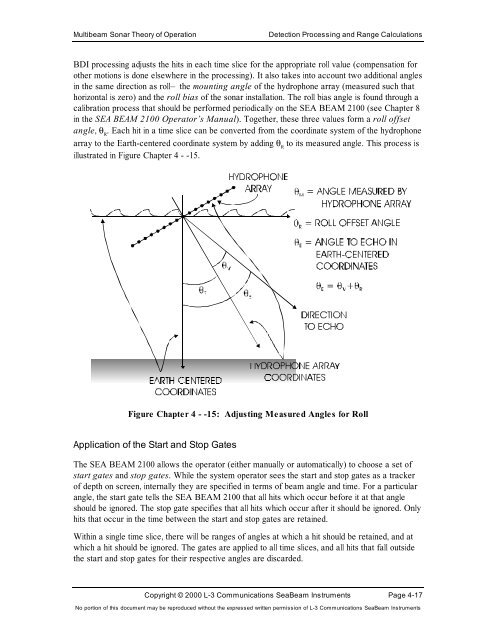Multibeam Sonar Theory of Operation
Multibeam Sonar Theory of Operation
Multibeam Sonar Theory of Operation
You also want an ePaper? Increase the reach of your titles
YUMPU automatically turns print PDFs into web optimized ePapers that Google loves.
<strong>Multibeam</strong> <strong>Sonar</strong> <strong>Theory</strong> <strong>of</strong> <strong>Operation</strong> Detection Processing and Range Calculations<br />
BDI processing adjusts the hits in each time slice for the appropriate roll value (compensation for<br />
other motions is done elsewhere in the processing). It also takes into account two additional angles<br />
in the same direction as roll— the mounting angle <strong>of</strong> the hydrophone array (measured such that<br />
horizontal is zero) and the roll bias <strong>of</strong> the sonar installation. The roll bias angle is found through a<br />
calibration process that should be performed periodically on the SEA BEAM 2100 (see Chapter 8<br />
in the SEA BEAM 2100 Operator’s Manual). Together, these three values form a roll <strong>of</strong>fset<br />
angle, θ R . Each hit in a time slice can be converted from the coordinate system <strong>of</strong> the hydrophone<br />
array to the Earth-centered coordinate system by adding θ R to its measured angle. This process is<br />
illustrated in Figure Chapter 4 - -15.<br />
Figure Chapter 4 - -15: Adjusting Measured Angles for Roll<br />
Application <strong>of</strong> the Start and Stop Gates<br />
The SEA BEAM 2100 allows the operator (either manually or automatically) to choose a set <strong>of</strong><br />
start gates and stop gates. While the system operator sees the start and stop gates as a tracker<br />
<strong>of</strong> depth on screen, internally they are specified in terms <strong>of</strong> beam angle and time. For a particular<br />
angle, the start gate tells the SEA BEAM 2100 that all hits which occur before it at that angle<br />
should be ignored. The stop gate specifies that all hits which occur after it should be ignored. Only<br />
hits that occur in the time between the start and stop gates are retained.<br />
Within a single time slice, there will be ranges <strong>of</strong> angles at which a hit should be retained, and at<br />
which a hit should be ignored. The gates are applied to all time slices, and all hits that fall outside<br />
the start and stop gates for their respective angles are discarded.<br />
Copyright © 2000 L-3 Communications SeaBeam Instruments Page 4-17<br />
No portion <strong>of</strong> this document may be reproduced without the expressed written permission <strong>of</strong> L-3 Communications SeaBeam Instruments
















